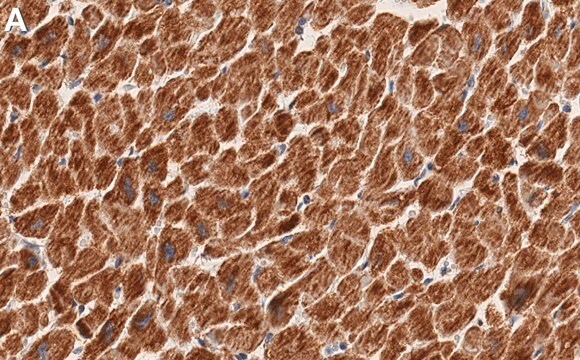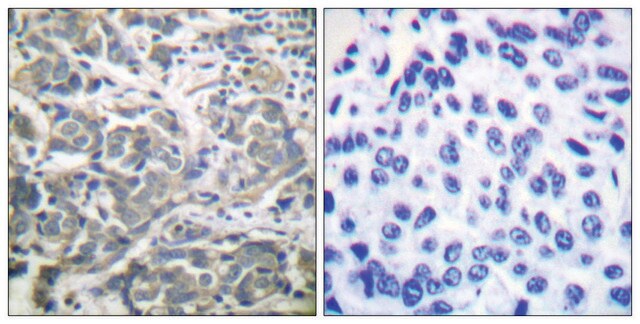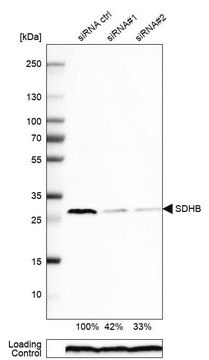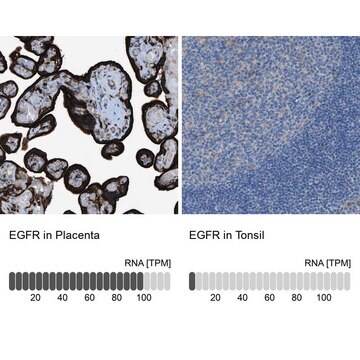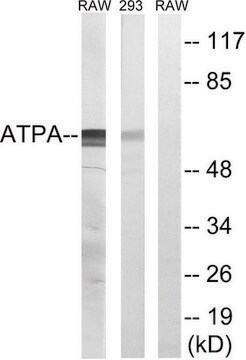일반 설명
We are committed to bringing you greener alternative products, which adhere to one or more of The 12 Principles of Green Chemistry.This antibody is Preservative-free, produced without the harm or sacrifice of animals and exceptionally stable to allow for ambient shipping and storage if needed and thus aligns with "Waste Prevention", "Designing Safer Chemicals" and "Design for Energy Efficiency".
Click here for more information.
ZooMAb® antibodies represent an entirely new generation of recombinant monoclonal antibodies.
Each ZooMAb® antibody is manufactured using our proprietary recombinant expression system, purified to homogeneity, and precisely dispensed to produce robust and highly reproducible lot-to-lot consistency. Only top-performing clones are released for use by researchers. Each antibody is validated for high specificity and affinity across multiple applications, including its most commonly used application. ZooMAb® antibodies are reliably available and ready to ship when you need them.
특이성
Clone 1H11 is a ZooMAb® Rabbit recombinant monoclonal antibody that specifically detects Succinate dehydrogenase [ubiquinone] iron-sulfur subunit, mitochondrial (SDHB). It targets an epitope within 17 amino acids from the internal region.
면역원
KLH-conjugated linear peptide corresponding to 17 amino acids from the internal region of human Succinate dehydrogenase [ubiquinone] iron-sulfur subunit, mitochondrial (SDHB).
애플리케이션
Quality Control Testing
Evaluated by Western Blotting in mouse heart tissue lysate.
Western Blotting Analysis: A 1:10,000 dilution of this antibody detected SDHB in mouse heart tissue lysate.
Tested applications
Western Blotting Analysis: A 1:10,000 dilution from a representative lot detected SDHB in lysates from rat and human heart tissue and L6 cells.
Immunofluorescence Analysis: A 1:100 dilution from a representative lot detected SDHB in human kidney tissue sections.
Immunohistochemistry (Paraffin) Analysis: A 1:100 dilution from a representative lot detected SDHB in human kidney and human heart tissue sections.
Affinity Binding Assay: A representative lot of this antibody bound SDHB with a KD of 3.9 x 10-7 in an affinity binding assay.
Note: Actual optimal working dilutions must be determined by end user as specimens, and experimental conditions may vary with the end user
표적 설명
Succinate dehydrogenase [ubiquinone] iron-sulfur subunit, mitochondrial (UniProt: P21912; also known as EC:1.3.5.1, Iron-sulfur subunit of complex II, Ip, SDHB) is encoded by the SDHB (also known as SDH, SDH1) gene (Gene ID: 6390) in human. Succinate dehydrogenase (SDH) is a holoenzyme consisting of four essential subunits, SDHA (a flavoprotein), SDHB (iron-sulfur protein), and two membrane anchor units SDHC and SDHD. SDH assembly requires two factors, SDHAF1 and SDHAF2, while its function is influenced by the deacetylase activity of SIRT3. SDH is the only enzyme complex known to participate in both the TCA cycle and electron transport chain (ETC). It catalyzes the oxidation of succinate in the TCA cycle to form fumarate, a reaction that is coupled to the reduction of ubiquinone to ubiquinol in the ETC. SDHB is a highly conserved inner mitochondrial membrane protein that serves as an iron-sulfur protein subunit of SDH that is involved in complex II of the mitochondrial electron transport chain and is responsible for transferring electrons from succinate to ubiquinone (coenzyme Q). It is involved in step 1 of the sub-pathway that synthesizes fumarate from succinate. It contains three cysteine-rich clusters that comprise the iron-sulfur centers of the enzyme. Mutations in SDHB gene have been linked to Pheochromocytoma, a catecholamine-producing tumor of chromaffin tissue of the adrenal medulla leading to persistent hypertension and also to Paraganglioma and gastric stromal sarcoma. This ZooMAb® recombinant monoclonal antibody, generated by our propriety technology, offers significantly enhanced specificity, affinity, reproducibility, and stability over conventional monoclonals.
물리적 형태
Purified recombinant rabbit monoclonal antibody IgG, lyophilized in PBS, 5% Trehalose, normal appearance a coarse or translucent resin. The PBS/trehalose components in the ZooMAb formulation can have the appearance of a semi-solid (bead like gel) after lyophilization. This is a normal phenomenon. Please follow the recommended reconstitution procedure in the data sheet to dissolve the semi-solid, bead-like, gel-appearing material. The resulting antibody solution is completely stable and functional as proven by full functional testing. Contains no biocide or preservatives, such as azide, or any animal by-products. Larger pack sizes provided as multiples of 25 μL.
재구성
300 μg/mL after reconstitution at 25 μL per vial. Please refer to guidance on suggested starting dilutions and/or titers per application and sample type.
저장 및 안정성
Recommend storage of lyophilized product at 2-8°C; Before reconstitution, micro-centrifuge vials briefly to spin down material to bottom of the vial; Reconstitute each vial by adding 25 μL of filtered lab grade water or PBS; Reconstituted antibodies can be stored at 2-8°C, or -20°C for long term storage. Avoid repeated freeze-thaws.
법적 정보
ZooMAb is a registered trademark of Merck KGaA, Darmstadt, Germany
면책조항
Unless otherwise stated in our catalog or other company documentation accompanying the product(s), our products are intended for research use only and are not to be used for any other purpose, which includes but is not limited to, unauthorized commercial uses, in vitro diagnostic uses, ex vivo or in vivo therapeutic uses or any type of consumption or application to humans or animals.

